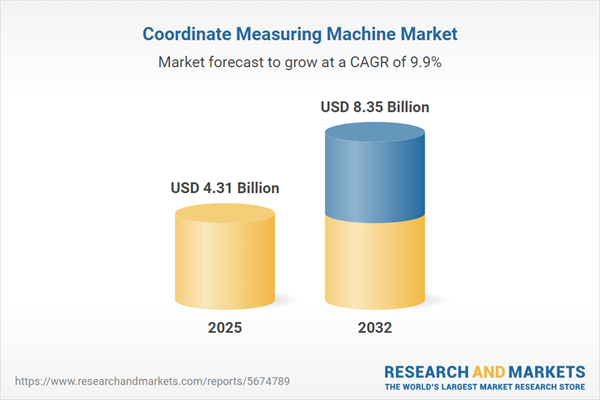Speak directly to the analyst to clarify any post sales queries you may have.
The coordinate measuring machine (CMM) market is rapidly transforming, driven by the increasing demand for advanced precision, reliability, and efficiency across manufacturing environments. Growing complexity in industrial standards and regulatory requirements is compelling businesses to invest in innovative metrology solutions to maintain a competitive edge.
Market Snapshot: Coordinate Measuring Machine Market Size and Growth
The coordinate measuring machine market grew from USD 3.91 billion in 2024 to USD 4.31 billion in 2025. It is forecast to expand at a compound annual growth rate (CAGR) of 9.92%, reaching USD 8.35 billion by 2032. Robust adoption in industries such as aerospace, automotive, electronics, energy, and medical devices continues to fuel this momentum, driven by investments in integrated quality assurance and manufacturing automation.
Scope & Segmentation
This report delivers an in-depth analysis of the global coordinate measuring machine market, highlighting core segmentation perspectives and regional performance drivers.
- End User Industry: Aerospace and defense; automotive; electronics; energy and power; medical devices.
- Machine Type: Articulating arm; bridge; cantilever; gantry; horizontal arm.
- Sensor Type: Multi sensor (laser and vision combined, tactile and optical combined); optical (laser scanning, structured light scanner, white light scanner); tactile (scanning probe, touch trigger probe).
- Application: Assembly guidance; in-line measurement; inspection; reverse engineering.
- Region: Americas (North America – United States, Canada, Mexico; Latin America – Brazil, Argentina, Chile, Colombia, Peru); Europe, Middle East & Africa (Europe – United Kingdom, Germany, France, Russia, Italy, Spain, Netherlands, Sweden, Poland, Switzerland; Middle East – United Arab Emirates, Saudi Arabia, Qatar, Turkey, Israel; Africa – South Africa, Nigeria, Egypt, Kenya); Asia-Pacific (China, India, Japan, Australia, South Korea, Indonesia, Thailand, Malaysia, Singapore, Taiwan).
- Leading Companies: Hexagon AB; Carl Zeiss AG; Nikon Corporation; Mitutoyo Corporation; Creaform Inc.; Guindy Machine Tools; Sipcon Technologies Pvt. Ltd.; Baker Gauges India Pvt. Ltd.; XI'AN LEAD METROLOGY CO., LTD; Tech - Ed Equipment Company.
Key Takeaways for Senior Decision-Makers
- Advanced sensor fusion technologies combining optical, structured light, and tactile probing are enabling detailed microdefect detection and multi-modal inspections, addressing higher complexity in manufacturing environments.
- Seamless integration of digital thread and enterprise software systems is supporting real-time data-driven feedback, driving shorter inspection cycles and proactive quality management.
- Automation and robotics have expanded CMM deployment to dynamic and high-throughput applications, such as in-line automotive assembly and large-scale component verification in aerospace.
- The influence of global trade policies, particularly recent United States tariff adjustments, is motivating a shift toward localizing component manufacturing to increase supply chain resilience and manage production costs.
- Reverse engineering and assembly guidance remain critical application drivers, especially in medical devices and electronic component analysis, unlocking new possibilities for digital twin creation and prototyping.
- Regional differences are pronounced, with the Americas focusing on reshoring, EMEA leveraging engineering hubs and automation, and Asia-Pacific prioritizing rapid adoption and local innovation.
Tariff Impact: Navigating US Trade Policy Shifts
The 2025 implementation of new United States tariffs has restructured CMM supply chains. Original equipment manufacturers and suppliers increasingly localize production and strengthen domestic sourcing to minimize tariff exposure. Margins are affected as import costs rise, but investments in automation and collaborative supplier strategies are offsetting some of these challenges. This shift encourages the adoption of domestically produced articulating arm and bridge-type systems, allowing buyers to better manage lead times and pricing stability.
Methodology & Data Sources
This report synthesizes insights from primary interviews with senior executives and engineers, as well as comprehensive secondary research from leading industry publications, technical papers, and regulatory documentation. Methodological rigor was ensured via expert advisory panels and stakeholder validation workshops, supporting reliable and actionable conclusions.
Why This Report Matters
- Enables leaders to benchmark against global and regional market developments for strategic decision-making.
- Highlights opportunities to adopt emerging technologies such as sensor fusion and digital thread integration, enhancing operational efficiency and quality.
- Identifies actionable strategies to mitigate risks from shifting trade policies and regional market disruptions.
Conclusion
The coordinate measuring machine market offers compelling growth opportunities for manufacturers prioritizing precision and automation. Informed investment in advanced technologies, supply chain strategies, and skilled talent will help industry leaders achieve operational excellence and sustained competitive differentiation.
Additional Product Information:
- Purchase of this report includes 1 year online access with quarterly updates.
- This report can be updated on request. Please contact our Customer Experience team using the Ask a Question widget on our website.
Table of Contents
3. Executive Summary
4. Market Overview
7. Cumulative Impact of Artificial Intelligence 2025
Companies Mentioned
The companies profiled in this Coordinate Measuring Machine market report include:- Hexagon AB
- Carl Zeiss AG
- Nikon Corporation
- Mitutoyo Corporation
- Creaform Inc.
- Guindy Machine Tools
- Sipcon Technologies Pvt. Ltd.
- Baker Gauges India Pvt. Ltd.
- XI'AN LEAD METROLOGY CO., LTD
- Tech - Ed Equipment Company
Table Information
| Report Attribute | Details |
|---|---|
| No. of Pages | 184 |
| Published | October 2025 |
| Forecast Period | 2025 - 2032 |
| Estimated Market Value ( USD | $ 4.31 Billion |
| Forecasted Market Value ( USD | $ 8.35 Billion |
| Compound Annual Growth Rate | 9.9% |
| Regions Covered | Global |
| No. of Companies Mentioned | 11 |









